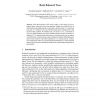Free Online Productivity Tools
i2Speak
i2Symbol
i2OCR
iTex2Img
iWeb2Print
iWeb2Shot
i2Type
iPdf2Split
iPdf2Merge
i2Bopomofo
i2Arabic
i2Style
i2Image
i2PDF
iLatex2Rtf
Sci2ools
WADS
2009
Springer
2009
Springer
Rank-Balanced Trees
Since the invention of AVL trees in 1962, a wide variety of ways to balance binary search trees have been proposed. Notable are red-black trees, in which bottom-up rebalancing after an insertion or deletion takes O(1) amortized time and O(1) rotations worst-case. But the design space of balanced trees has not been fully explored. We introduce the rank-balanced tree, a relaxation of AVL trees. Rank-balanced trees can be rebalanced bottom-up after an insertion or deletion in O(1) amortized time and at most two rotations worst-case, in contrast to red-black trees, which need up to three rotations per deletion. Rebalancing can also be done top-down with fixed lookahead in O(1) amortized time. Using a novel analysis that relies on an exponential potential function, we show that both bottom-up and top-down rebalancing modify nodes exponentially infrequently in their heights.
| Added | 25 May 2010 |
| Updated | 25 May 2010 |
| Type | Conference |
| Year | 2009 |
| Where | WADS |
| Authors | Bernhard Haeupler, Siddhartha Sen, Robert Endre Tarjan |
Comments (0)

